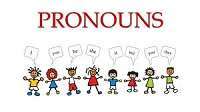Pronoun Definition
A pronoun is a noun with another name.
What is a Pronoun?
Read the following sentence :
Mrs Grewal is a teacher in Karnal High School. She is loved by all the students. They gave her a present. The words ‘she’, ‘they’ and ‘her’ are used in place of Mrs Singh and the students to avoid repetition. They are called pronouns.
Rule—A Pronoun is a word used in place of a noun
(1) I went to a shop last night.
(2) We will go to the market tomorrow.
(3) Give me some sugar in the tea.
(4) Where are you going?
(5) They went out.
(6) They went home.
The words ‘I, we, me, you, they’ are all pronouns. A pronoun that stands for a person or thing is called a personal pronoun.
1.Personal Pronouns
Personal pronouns are so called as they stand three persons.
(a) The person or persons speaking is the first person. I, me, we, our, us, mine etc.
(b) The person or persons have spoken to is/are dying the second person. You and yours.
| Person | Singular | Plural | Gender |
| 1st
2nd
3rd |
I, me, mine
you and yours He, him, his, she, she, her, hers, its, its |
we, us, irs
you am ours ——— ———— ——— ————- ——— ———— They, them, theirs |
used for both males
and females (common). used for both males and females. used for males. used for females. used for non-living things. used for males, females, animals and non-living things. |
2. Reflexive Pronouns
Look at these sentences :
(1) I cook for myself.
(2) We often talk about ourselves.
(3) They will go by themselves.
(4) He wrote the essay himself.
(5) The ball fell by itself.
The pronouns in bold are reflexive pronouns.
In the above sentences, you see the doer of the action is also the receiver of the action.
The pronouns myself ourselves, themselves, himself itself yourselves are receivers of action and hence are called reflexive pronouns.
3. Emphatic Pronouns
Look at these sentences :
(1) I myself knitted the sweater.
(2) She herself gave the sweets.
(3) We ourselves told the children to come.
(4) They themselves ran away.
(5) He himself promised to help.
(6) You talk yourself about the problem.
The pronouns myself, themselves, ourselves, himself, herself yourself have been used.
A pronoun that is used for the sake of emphasis is called an emphatic pronoun.
4. Demonstrative Pronouns
Look at these sentences :
(1) This is my purse.
(2) These clothes are mine.
(3) Those are your clothes.
(4) That house belongs to Sujata.
The pronouns this, that, those and these are used to point at object or objects they refer to so they are called demonstrative pronouns.
A pronoun that is used to point at the object or objects they refer to is called a demonstrative pronoun.
That and this is used for singular objects. Those and these are used for plural objects. Thai and those are used for objects that are far and this and these for objects that are near.
5. Indefinite Pronouns
Look at these sentences :
(1) One is filled with admiration on seeing the ancient temples.
(2) Some people are born great.
(3) Many people died in the riots.
(4) Few escaped unhurt.
(5) I hope somebody will help me.
A pronoun which refers to persons and things in a general way and not to any person or thing, in particular, is known as an Indefinite Pronoun.
6. Distributive Pronouns
Look at these sentences :
(1) Each of the children got a box of sweets.
(2) Either of these books will help you.
(3) Neither of the stories is true.
Each, either, and neither are known as distributive pronouns as they refer to persons or things one at a time.
(1) What is your name?
(2) Who is standing there?
(3) Whom do you like the most?
(4) Which is your box?
The pronouns which, what, whom and who have been used to ask questions.
A pronoun that is used to ask a question is called an Interrogative pronoun.
7. Relative Pronouns
Look at these sentences :
(1)This is the woman. She paints well.
This is the woman who paints well.
(2)This is the man. His son is an engineer.
This is the man whose son is an engineer.
(3)This is a drawing. Radha did it.
This is a drawing that Radha did.
(4)This is Sajjan. The teachers like him.
This is Sajjan whom the teachers like.
(5)This is the car. It won the race.
This is the car which won the race.
The pronouns who, whose, that, whom and which are relative pronouns. These are used to join two sentences together and refer to nouns going before them.
8. Possessive Pronouns
Look at these sentences :
(1) That is my house.
(2) That house is mine.
In a sentence I, my qualifies the noun ‘house’ so my is an adjective. It is showing possession and hence is known as a possessive adjective.
In sentence 2, the same thing has been expressed in a different way. Here mine is a pronoun which is showing possession. Hence it is called possessive Pronoun.
A pronoun showing possession is called a possessive pronoun.
Pronoun Exercises
Pronouns Exercise No.1
Pronouns Exercise No.2
